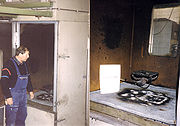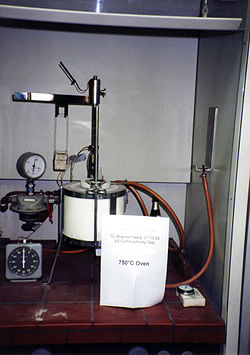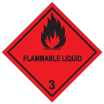
Flammability
Encyclopedia




Fire
Fire is the rapid oxidation of a material in the chemical process of combustion, releasing heat, light, and various reaction products. Slower oxidative processes like rusting or digestion are not included by this definition....
or combustion
Combustion
Combustion or burning is the sequence of exothermic chemical reactions between a fuel and an oxidant accompanied by the production of heat and conversion of chemical species. The release of heat can result in the production of light in the form of either glowing or a flame...
. The degree of difficulty required to cause the combustion of a substance is quantified through fire test
Fire test
A fire test is a means of determining whether or not fire protection products meet minimum performance criteria as set out in a building code or other applicable legislation. Successful tests in laboratories holding national accreditation for testing and certification result in the issuance of a...
ing. Internationally, a variety of test protocols exist to quantify flammability. The ratings achieved are used in building code
Building code
A building code, or building control, is a set of rules that specify the minimum acceptable level of safety for constructed objects such as buildings and nonbuilding structures. The main purpose of building codes are to protect public health, safety and general welfare as they relate to the...
s, insurance requirements, fire codes and other regulations governing the use of building materials as well as the storage and handling of highly flammable substances inside and outside of structures and in surface and air transportation. For instance, changing an occupancy
Occupancy
Occupancy in building construction and building codes is the use or intended use of a building or part thereof for the shelter or support of persons, animals or property. A closely related meaning is the number of units in such a building that are rented or leased, or otherwise in-use...
by altering the flammability of the contents requires the owner of a building
Building
In architecture, construction, engineering, real estate development and technology the word building may refer to one of the following:...
to apply for a building permit to make sure that the overall fire protection
Fire protection
Fire protection is the study and practice of mitigating the unwanted effects of fires. It involves the study of the behaviour, compartmentalisation, suppression and investigation of fire and its related emergencies, as well as the research and development, production, testing and application of...
design basis of the facility can take the change into account.
Testing
A fire testFire test
A fire test is a means of determining whether or not fire protection products meet minimum performance criteria as set out in a building code or other applicable legislation. Successful tests in laboratories holding national accreditation for testing and certification result in the issuance of a...
can be conducted to determine the degree of flammability. Test standards used to make this determination but are not limited to the following:
- Underwriters LaboratoriesUnderwriters LaboratoriesUnderwriters Laboratories Inc. is an independent product safety certification organization. Established in 1894, the company has its headquarters in Northbrook, Illinois. UL develops standards and test procedures for products, materials, components, assemblies, tools and equipment, chiefly dealing...
UL 94 Flammability Testing - International Electrotechnical CommissionInternational Electrotechnical CommissionThe International Electrotechnical Commission is a non-profit, non-governmental international standards organization that prepares and publishes International Standards for all electrical, electronic and related technologies – collectively known as "electrotechnology"...
IEC 60707, 60695-11-10 and 60695-11-20 - International Organization for StandardizationInternational Organization for StandardizationThe International Organization for Standardization , widely known as ISO, is an international standard-setting body composed of representatives from various national standards organizations. Founded on February 23, 1947, the organization promulgates worldwide proprietary, industrial and commercial...
ISO 9772 and 9773. - National Fire Protection AssociationNational Fire Protection AssociationThe National Fire Protection Association is a United States trade association that creates and maintains private, copywrited, standards and codes for usage and adoption by local governments...
NFPA 287 Standard Test Methods for Measurement of Flammability of Materials in Cleanrooms Using a Fire Propagation Apparatus (FPA) - NFPA 701: Standard Methods of Fire Tests for Flame Propagation of Textiles and Films
Categorization of building materials
Materials can be tested for the degree of flammability and combustibility in accordance with the German DIN 4102. DIN 4102, as well as its British cousin BS 476 include for testing of passive fire protectionPassive fire protection
Passive fire protection is an integral component of the three components of structural fire protection and fire safety in a building. PFP attempts to contain fires or slow the spread, through use of fire-resistant walls, floors, and doors...
system
System
System is a set of interacting or interdependent components forming an integrated whole....
s, as well as some if its constituent materials.
The following are the categories in order of degree of combustibility
Combustibility
Combustibility is a measure of how easily a substance will set on fire, through fire or combustion. This is an important property to consider when a substance is used for construction or is being stored. Special precautions are usually required for substances that are easily combustible...
as well as flammability:
| Rating | Degree of flammability | Examples |
|---|---|---|
| A1 | 100% noncombustible (nichtbrennbar) | |
| A2 | ~98% noncombustible (nichtbrennbar) | |
| B1 | Difficult to ignite (schwer entflammbar) | intumescent Intumescent An intumescent is a substance which swells as a result of heat exposure, thus increasing in volume, and decreasing in density. Intumescents are typically used in passive fire protection and, in America, require listing and approval use and compliance in their installed configurations in order to... s and some high end silicone Silicone Silicones are inert, synthetic compounds with a variety of forms and uses. Typically heat-resistant and rubber-like, they are used in sealants, adhesives, lubricants, medical applications , cookware, and insulation.... s |
| B2 | Normal combustibility | wood Wood Wood is a hard, fibrous tissue found in many trees. It has been used for hundreds of thousands of years for both fuel and as a construction material. It is an organic material, a natural composite of cellulose fibers embedded in a matrix of lignin which resists compression... |
| B3 | Easily ignited (leichtentflammbar) |
A more recent norm is the European EN 13501-1 - Fire classification of construction products and building elements - which roughly replaces A2 with A2/B, B1 with C, B2 with D/E and B3 with F.
B3 or F rated materials may not be used in building unless combined with another material which reduces the flammability of those materials.
Flash point
A material's flash pointFlash point
The flash point of a volatile material is the lowest temperature at which it can vaporize to form an ignitable mixture in air. Measuring a flash point requires an ignition source...
is a metric of how easy it is to ignite the vapor of the material as it evaporates into the atmosphere. A lower flash point indicates higher flammability. Materials with a flash points below 100 °F (37.8 °C) are regulated in the United States
United States
The United States of America is a federal constitutional republic comprising fifty states and a federal district...
by OSHA
Occupational Safety and Health Administration
The United States Occupational Safety and Health Administration is an agency of the United States Department of Labor. It was created by Congress of the United States under the Occupational Safety and Health Act, signed by President Richard M. Nixon, on December 29, 1970...
as potential workplace hazards.
Vapor pressure
- The vapor pressureVapor pressureVapor pressure or equilibrium vapor pressure is the pressure of a vapor in thermodynamic equilibrium with its condensed phases in a closed system. All liquids have a tendency to evaporate, and some solids can sublimate into a gaseous form...
of a liquid, which varies with its temperature, is a measure of how much the vapor of the liquid tends to concentrate in the surrounding atmosphere as the liquid evaporates. Vapor pressure is a major determinant of the flash point, with higher vapor pressures leading to lower flash points and higher flammability.
Examples of flammable liquids
Flammable liquidFlammable liquid
Generally, a flammable liquid is a liquid that can catch fire.In the USA, there is a precise definition of flammable liquid as one with a flash point below 100 degrees Fahrenheit. Less-flammable liquids are defined as combustible liquids...
s include, but are not limited to:
- GasolineGasolineGasoline , or petrol , is a toxic, translucent, petroleum-derived liquid that is primarily used as a fuel in internal combustion engines. It consists mostly of organic compounds obtained by the fractional distillation of petroleum, enhanced with a variety of additives. Some gasolines also contain...
/ a complicated mixture of hydrocarbons that includes isomers of octaneOctaneOctane is a hydrocarbon and an alkane with the chemical formula C8H18, and the condensed structural formula CH36CH3. Octane has many structural isomers that differ by the amount and location of branching in the carbon chain...
, C8H18 - EthanolEthanolEthanol, also called ethyl alcohol, pure alcohol, grain alcohol, or drinking alcohol, is a volatile, flammable, colorless liquid. It is a psychoactive drug and one of the oldest recreational drugs. Best known as the type of alcohol found in alcoholic beverages, it is also used in thermometers, as a...
/ CH3CH2OH - Isopropanol / CH3CH(OH)CH3
- MethanolMethanolMethanol, also known as methyl alcohol, wood alcohol, wood naphtha or wood spirits, is a chemical with the formula CH3OH . It is the simplest alcohol, and is a light, volatile, colorless, flammable liquid with a distinctive odor very similar to, but slightly sweeter than, ethanol...
/ CH3OH - AcetoneAcetoneAcetone is the organic compound with the formula 2CO, a colorless, mobile, flammable liquid, the simplest example of the ketones.Acetone is miscible with water and serves as an important solvent in its own right, typically as the solvent of choice for cleaning purposes in the laboratory...
/ CH3COCH3 - NitromethaneNitromethaneNitromethane is an organic compound with the chemical formula . It is the simplest organic nitro compound. It is a slightly viscous, highly polar liquid commonly used as a solvent in a variety of industrial applications such as in extractions, as a reaction medium, and as a cleaning solvent...
/ CH3NO2
Classification of flammability
The US Government uses the Hazardous Materials Identification SystemHazardous Materials Identification System
HMIS is a numerical hazard rating that incorporates the use of labels with color-coded bars as well as training materials...
(HMIS) standard for flammability ratings, as do many US regulatory agencies, and also the US National Fire Protection Association
National Fire Protection Association
The National Fire Protection Association is a United States trade association that creates and maintains private, copywrited, standards and codes for usage and adoption by local governments...
(NFPA).
The ratings are as follows:
| Rating | Degree of flammability | Examples |
|---|---|---|
| 0 | Materials that will not burn | water Water Water is a chemical substance with the chemical formula H2O. A water molecule contains one oxygen and two hydrogen atoms connected by covalent bonds. Water is a liquid at ambient conditions, but it often co-exists on Earth with its solid state, ice, and gaseous state . Water also exists in a... |
| 1 | Materials that must be preheated before they will ignite | lubricating oils, cooking oils |
| 2 | Materials that must be moderately heated or exposed to relatively high ambient temperatures before they will ignite | diesel fuel |
| 3 | Liquids and solids that can ignite under almost all temperature conditions | gasoline Gasoline Gasoline , or petrol , is a toxic, translucent, petroleum-derived liquid that is primarily used as a fuel in internal combustion engines. It consists mostly of organic compounds obtained by the fractional distillation of petroleum, enhanced with a variety of additives. Some gasolines also contain... , acetone Acetone Acetone is the organic compound with the formula 2CO, a colorless, mobile, flammable liquid, the simplest example of the ketones.Acetone is miscible with water and serves as an important solvent in its own right, typically as the solvent of choice for cleaning purposes in the laboratory... |
| 4 | Materials which will rapidly vaporize at atmospheric pressure and normal temperatures, or are readily dispersed in air and which burn readily | natural gas Natural gas Natural gas is a naturally occurring gas mixture consisting primarily of methane, typically with 0–20% higher hydrocarbons . It is found associated with other hydrocarbon fuel, in coal beds, as methane clathrates, and is an important fuel source and a major feedstock for fertilizers.Most natural... , propane Propane Propane is a three-carbon alkane with the molecular formula , normally a gas, but compressible to a transportable liquid. A by-product of natural gas processing and petroleum refining, it is commonly used as a fuel for engines, oxy-gas torches, barbecues, portable stoves, and residential central... , butane Butane Butane is a gas with the formula C4H10 that is an alkane with four carbon atoms. The term may refer to any of two structural isomers, or to a mixture of them: in the IUPAC nomenclature, however, butane refers only to the unbranched n-butane isomer; the other one being called "methylpropane" or... |
Flammability
For existing buildings, fire codes focus on maintaining the occupanciesOccupancy
Occupancy in building construction and building codes is the use or intended use of a building or part thereof for the shelter or support of persons, animals or property. A closely related meaning is the number of units in such a building that are rented or leased, or otherwise in-use...
as originally intended. In other words, if a portion of a building were designed as an apartment
Apartment
An apartment or flat is a self-contained housing unit that occupies only part of a building...
, one could not suddenly load it with flammable liquids and turn it into a gas storage facility, because the fire load and smoke development in that one apartment would be so immense as to overtax the active fire protection
Active fire protection
Active fire protection is an integral part of fire protection. AFP is characterised by items and/or systems, which require a certain amount of motion and response in order to work, contrary to passive fire protection.-Fire suppression:...
as well as the passive fire protection
Passive fire protection
Passive fire protection is an integral component of the three components of structural fire protection and fire safety in a building. PFP attempts to contain fires or slow the spread, through use of fire-resistant walls, floors, and doors...
means for the building. The handling and use of flammable substances inside a building is subject to the local fire code, which is ordinarily enforced by the local fire prevention officer.
Linguistics: flammable vs. inflammable
Flammable and inflammable both mean capable of burning. The word "inflammable" came from Latin inflammāre = "to set fire to," where the prefix "in-" means "in" as in "indoctrinate", rather than "not" as in "invisible" and "ineligible". Nonetheless, "inflammable" is often erroneously thought to mean "non-flammable". This safety hazard has been avoided by the use of flammable on warning labels referring to physical combustibility. In the United States the word inflammable has been largely abandoned in common, scientific, industrial, and written language. Antonymns of flammable/inflammable are non-flammable, non-inflammable, incombustible, non-combustible, or simply "not flammable".See also
- Fire testFire testA fire test is a means of determining whether or not fire protection products meet minimum performance criteria as set out in a building code or other applicable legislation. Successful tests in laboratories holding national accreditation for testing and certification result in the issuance of a...
- Fire protectionFire protectionFire protection is the study and practice of mitigating the unwanted effects of fires. It involves the study of the behaviour, compartmentalisation, suppression and investigation of fire and its related emergencies, as well as the research and development, production, testing and application of...
- Active fire protectionActive fire protectionActive fire protection is an integral part of fire protection. AFP is characterised by items and/or systems, which require a certain amount of motion and response in order to work, contrary to passive fire protection.-Fire suppression:...
- Passive fire protectionPassive fire protectionPassive fire protection is an integral component of the three components of structural fire protection and fire safety in a building. PFP attempts to contain fires or slow the spread, through use of fire-resistant walls, floors, and doors...
- Flammable liquidFlammable liquidGenerally, a flammable liquid is a liquid that can catch fire.In the USA, there is a precise definition of flammable liquid as one with a flash point below 100 degrees Fahrenheit. Less-flammable liquids are defined as combustible liquids...
s - Lower flammable limitLower flammable limitLower flammability limit , usually expressed in volume per cent, is the lower end of the concentration range of a flammable solvent at a given temperature and pressure for which air/vapor mixtures can ignite. The flammability range is delineated by the upper and lower flammability limit. Outside...
- Upper flammable limit

